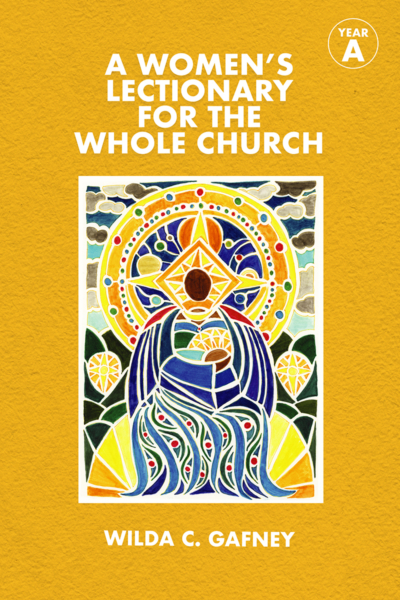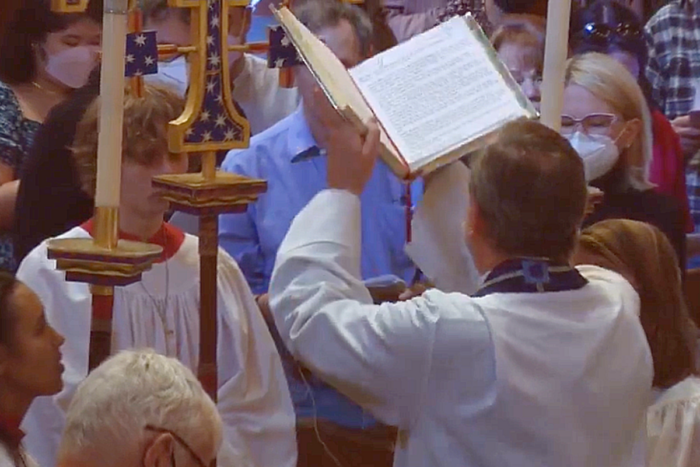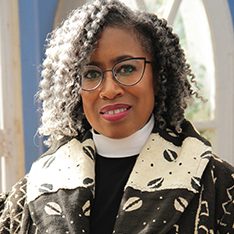Some churches adopt ‘Women’s Lectionary’ this Advent, centering women’s stories, expanding languagePosted Dec 9, 2022 |
|
[Episcopal News Service] Choosing Scripture for a Sunday worship service doesn’t require guesswork. Most mainline Protestant churches follow the same three-year cycle of Bible readings, known as the Revised Common Lectionary, or RCL, which was originally based on a Roman Catholic lectionary. So when Christians around the world began Advent on Nov. 27, they read the passage in Matthew’s Gospel that foreshadows the second coming of Jesus – “the coming of the Son of Man.”
But not members of St. James’ Episcopal Church in Freemont, California. Their Advent began with Mary’s story.
“For Advent, it just makes total sense for the entire season to be [told] through the woman’s perspective,” the Rev. Lori Walton, St. James’ rector, told Episcopal News Service. “We’re talking about pregnancy and birth and patience and anticipation and all the things that surround that. … And the RCL just doesn’t do that.”

“A Women’s Lectionary for the Whole Church” by the Rev. Wilda Gafney, with cover art by Pauline Williamson, was released in 2021 in Year W and Year A volumes. Year A is the first of a planned three-year cycle of Bible readings.
St. James’ is part of a growing number of Episcopal congregations that are stepping away, at least for this Advent, from the Revised Common Lectionary. In its place, they are testing out a new alternative, “A Women’s Lectionary for the Whole Church,” that was developed by the Rev. Wilda Gafney, a Hebrew Bible professor and Episcopal priest. Gafney selected readings for Sundays and holy days that center biblical women’s stories and perspectives, and she incorporates more feminine and gender-neutral language for the divine in her Bible translations.
Instead of Matthew, congregations like St. James’ that are following Gafney’s Year W lectionary read from the Gospel of Luke on Nov. 27. The Angel Gabriel visits Mary to tells her she will give birth to the son of God. Mary willingly accepts this role – as “woman-slave of God” in Gafney’s translation, a thought-provoking departure from the more common “servant.”
In Gafney’s hands, the Bible and the lectionary “really cause us to stop and think,” Walton said. “It has been so refreshing. I didn’t realize how old and stale the Revised Common Lectionary had become until we stepped out of it.”
Year W is a single-year schedule of Old and New Testament readings, Epistles and Psalms. It includes commentary and sermon suggestions by Gafney, the Rt. Rev. Sam B. Hulsey professor of Hebrew Bible at Brite Divinity School in Fort Worth, Texas. Other Episcopal congregations chose this Advent to follow Gafney’s Year A lectionary, the first in a planned three-year cycle that will parallel the Revised Common Lectionary.
Both volumes of “A Women’s Lectionary” were published in 2021 by Church Publishing, a division of the Episcopal nonprofit Church Pension Group. Year B and Year C will be published over the next two years.
On Dec. 5, Gafney was the guest speaker in a weekly Zoom session hosted by All Saints Episcopal Church in Pasadena, California, for clergy and lay leaders across The Episcopal Church who are trying out “A Women’s Lectionary” during Advent at their congregations. More than 40 people attended this week’s session, and additional weekly sessions are scheduled for the whole liturgical year.
All Saints has supported Gafney’s project from the start, including by testing out an early version of “A Women’s Lectionary” in 2020. The Pasadena church also named Gafney its “scholar in community” and has raised donations to help finance her work.
During All Saints’ hourlong Zoom session, Gafney described her own process of writing a sermon. She is scheduled to preach on her lectionary for the third Sunday in Advent on Dec. 11 at Trinity Episcopal Church in Fort Worth. After concluding the session by answering questions from participants, Gafney spoke separately with ENS about her project.
The idea came to her in October 2017, when she was scheduled to preach at a Sunday service and realized she hated the selection of readings from the Revised Common Lectionary, which she says tends to diminish the presence of women in the Bible. Her colleagues and social media followers encouraged her to develop a new lectionary that brought biblical women to the forefront.
“I wanted to produce, for myself and for others, a resource that focused on these neglected characters,” Gafney told ENS. Her selected readings for Advent include the stories of Hagar, Sarah, Hannah, Elizabeth and, from the book of Ruth, Rachel and Leah, who “built up the house of Israel.”
For the third Sunday of Advent, “A Women’s Lectionary” included a genealogy of Jesus that identifies the generations of mothers who preceded him – an alternative to the list of male ancestors that opens the Gospel of Matthew. The following Sunday introduces the story of Susanna, who was falsely accused of adultery. Her story comes from an apocryphal chapter of Daniel.
“Even though women are minoritized in the Scriptures – they’re often anonymized, they’re often reduced to reproduction – there’s still a lot of women whose names are preserved, who are present, for whom the promises of the larger narrative are much more complicated,” Gafney said.
Several priests interviewed by ENS said they received permission from their bishops to test out Gafney’s lectionary in their Sunday services. Newark Bishop Carlye Hughes offered guidance for clergy in her diocese to try it if they wished and asked them to provide feedback afterward, and Gafney led a workshop in May for Newark clergy.
Hughes, who previously served as rector of Gafney’s church, Trinity Episcopal in Fort Worth, praised Gafney’s “faithfulness and scholarship” in an emailed statement to ENS.
“At a time when every aspect of our faith life is expanding, to have options for expansive language for God and a wider view of Biblical peoples which includes women seems not only helpful, but vital for those struggling to see themselves as beloved members of the family of faith,” Hughes said. “A Women’s Lectionary” is not intended to replace the Revised Common Lectionary, Hughes added. “It is creating space for us to study, explore, and proclaim the wideness of God’s presence in our lives and world.”
It isn’t clear, however, that Episcopal bishops can authorize an alternative lectionary for Holy Eucharist on Sundays. General Convention in 2006 approved only the Revised Common Lectionary for use in Episcopal churches, and it rejected a resolution in 2009 seeking greater flexibility in choosing lectionaries. A 2012 resolution allowed bishops to grant exceptions, but only for congregations wishing to use the lectionary that was originally included in the 1979 Book of Common Prayer.
“The BCP expects that the Revised Common Lectionary will be used on all Sundays. It does not provide a process for an alternative, whether or not approved by the bishop,” the Rev. Ruth Meyers, a liturgics professor and leading churchwide expert on Episcopal liturgies, said by email in response to an ENS inquiry, without commenting specifically about “A Women’s Lectionary.”
The former bishop of Atlanta, the Rt. Rev. J. Neil Alexander, another respected church authority on liturgical revisions who is now the custodian of the Book of Common Prayer, emphasized by email that there is a difference between “an occasional adjustment” to the readings with a bishop’s permission and “the wholesale substitution of alternative lectionaries.” The latter is not allowed, he said.
It would be irresponsible for alternative lectionaries “to be widely used and simply replace the approved lectionaries of the church without authorization,” said Alexander, who retired in 2020 as dean of the School of Theology at the University of the South in Sewanee, Tennessee. Like Meyers, Alexander didn’t respond to “A Women’s Lectionary” directly, but he added that under certain circumstances the trial use of alternative readings might benefit The Episcopal Church’s “ongoing conversation on liturgical renewal and lectionary development.”
“In this season of liturgical growth and experimentation, it seems entirely possible for a bishop to commend the use of an alternative lectionary to one or two parishes in a diocese for a defined season of provisional use,” he said. The parishes should then report on their experience to bishops and churchwide authorities, “what they discovered to be commendable and what they found problematic.”
That is part of the spirit behind All Saints’ decision to test out the full three-year cycle of “A Women’s Lectionary” in its Sunday services, the Rev. Mike Kinman, All Saints’ rector, told ENS. He cited the congregation’s reputation as a kind of “research and development arm” of the Diocese of Los Angeles.
“We wanted to support this because it’s great work, but also it’s necessary work,” he said. “This really is an act of reparation. The reason these stories have not been centered and, in some cases, these stories have not been told is the people who put together the [Revised Common Lectionary] have done it really from a white, male lens.”

The Rev. Mike Kinman, rector of All Saints Episcopal Church in Pasadena, California, reads from the Gospel of Matthew on Nov. 27 as part of the church’s trial of “A Women’s Lectionary.”
Gafney said some Episcopal priests, on their own, may find “A Women’s Lectionary” to be a useful alternative to the Revised Common Lectionary readings, regardless of any debate over what is authorized for use. She also emphasized the full name of her project, “A Women’s Lectionary for the Whole Church” – not just for women and not just for Episcopalians, but for all Christians.
“I did not spend much time with the idea of whether this would be approved for The Episcopal Church,” she told ENS. “I discerned there was a need for this project, felt called to write it, hoped that it would be used in my community.”
The lectionary is not structured as a reaction to the Revised Common Lectionary, she said. Rather, she started with a blank page and assembled women-centric Bible readings that fit well together, that evoked the themes of feasts and seasons on the church calendar and that progressed cohesively though the liturgical year.
For the Bible translations, she initially thought she could take the New Revised Standard Version and “wiggle it a little bit where it needs to be wiggled,” but she quickly realized she needed to start from scratch. The translations in “A Women’s Lectionary” are her own.

The Rev. Wilda Gafney is the Rt. Rev. Sam B. Hulsey professor of Hebrew Bible at Brite Divinity School in Fort Worth, Texas. Photo: Brite Divinity School
The project was “prompted in part by my experience of hearing the scriptures read and proclaimed in nearly exclusively masculine language,” Gafney writes in the volumes’ introduction, so she deployed more feminine and gender-expansive language in translating the verses. In the interest of transparency, she includes explanations for those translation decisions and some of the scholarship behind them, and an appendix lists her suggested alternative terms and phrases for God and the divine.
She avoids the term “Lord,” for example. The story of Hagar refers to God as “the Wellspring of Life” and “the Fount of Life.” In the Psalms, her translations refer to God exclusively using feminine pronouns. And in her translation of Matthew, Jesus speaks of “the coming of the Son of Woman.”
“That certainly caught my attention,” said the Rev. Amity Carrubba, rector of Grace Episcopal Church in Chicago, Illinois. Her congregation is trying out “A Women’s Lectionary” for Advent and Christmas and probably will continue at least into Epiphany. “I think it’s a gift whenever we can hear the Holy Scriptures with fresh ears and a new perspective.”
In Hackettstown, New Jersey, St. James’ Episcopal Church in the Diocese of Newark is using “A Women’s Lectionary” for Sunday services this Advent after trying it out a year ago in a Bible study. Some members of the Bible study said it sounded strange to hear feminine pronouns for God in the chosen Psalms, but that strangeness dissipated after a few weeks, according to the Rev. Wayne Sherrer, priest-in-charge.
“The women in the Bible study made comments how the Psalms had become much more meaningful to them,” Sherrer told ENS.
Preaching on “A Women’s Lectionary” is a unique challenge, because most priests are accustomed to writing sermons based on the Revised Common Lectionary readings. Carrubba described herself as “both excited and frankly a little intimidated to try out an entire new lectionary.” It is joyous kind of anxiety. “As a woman and as a female cleric, I was intrigued by [Gafney’s] particular theological lens and perspective,” Carrubba said.
The Rev. Lizzie McManus-Dail, vicar of Jubilee Episcopal Church in Austin, Texas, also is following “A Women’s Lectionary” this Advent. Women have been part of God’s story from the beginning, she told ENS, but they haven’t been fully represented in the Revised Common Lectionary.
“The biggest celebration for me in this is that we get to hear women’s stories proclaimed in the service of the Holy Eucharist,” McManus-Dail said. Gafney’s lectionary readings and translation “prompt very different questions about what does our life of faith and walk with God look like,” McManus-Dail said.
Gafney acknowledged that some Christians who are used to the traditional lectionary and translations might see some of her choices as “a bridge too far,” but the response she has received so far to “A Women’s Lectionary” has been overwhelmingly positive.
“For the women who have dissolved in tears hearing that they are part of the sacred story, which was not communicated to them all of their life, in mass, in reading the Bible, in praying the Daily Office, people experience something akin to a conversion reading these passages,” Gafney said. “And I’m honored to help them find their way back into the scriptural tradition.”
– David Paulsen is an editor and reporter for Episcopal News Service. He can be reached at dpaulsen@episcopalchurch.org.

Social Menu